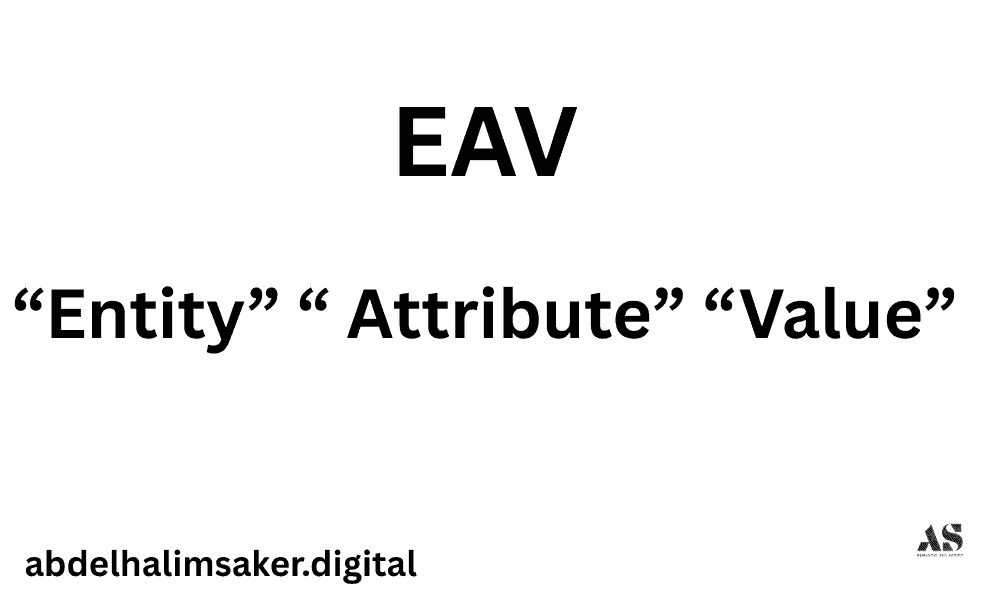
The Entity–Attribute–Value (EAV) model is a semantic structure that represents meaning through three interrelated components:
- Entities (the subject of information),
- Attributes (the properties or predicates that describe the entity), and
- Values (the resulting meaning or measurable outcome).
In Semantic SEO, the EAV model is the foundation of contextual understanding. It allows search engines like Google to interpret not just what words appear in content, but how concepts relate within a knowledge framework.
Example EAV triple:
“Semantic SEO (Entity) → improves (Attribute) → contextual relevance (Value).”
This structure mirrors how Google stores data in the Knowledge Graph — as interconnected meaning units.
Why the EAV Model Matters for Semantic SEO
Why is EAV critical in Semantic SEO?
Google’s understanding of meaning depends on semantic triples — subject–predicate–object relationships. These triples transform text into machine-readable context.
EAV enables:
- Knowledge extraction: Google converts text into entity-based relationships.
- Semantic indexing: Entities are stored based on shared attributes and values.
- Relevance recall: Queries are matched to content using conceptual meaning, not keyword strings.
When you apply the EAV model in SEO, you design content that aligns with Google’s Natural Language Processing (NLP) systems. This increases both retrieval accuracy and entity-level ranking stability.
EAV triples = structured meaning → improved semantic recall.
Components of the EAV Model
The EAV model consists of Entities, Attributes, and Values, which together create semantic triples — the atomic units of meaning.
| Component | Function | Example | Semantic Role |
|---|---|---|---|
| Entity | Subject of the statement | “Semantic SEO” | Defines the concept |
| Attribute | Descriptive predicate | “improves” | Defines the relationship |
| Value | Contextual outcome | “contextual relevance” | Provides measurable meaning |
Entities — The Core Subjects
Entities are identifiable concepts that carry meaning independently. They can represent people, organizations, topics, or ideas.
Examples of entities in SEO contexts:
- Semantic SEO (Concept)
- Google (Organization)
- Topical Authority (Metric)
- Knowledge Graph (System)
Entities form the “who” or “what” of every semantic statement.
In NLP, entities are extracted through Named Entity Recognition (NER) and linked to known records in Google’s Knowledge Graph. Recognized entities build semantic stability and improve cross-page comprehension.
Example:
“Google (Entity) → uses (Attribute) → Knowledge Graph (Value).”
This triple defines how one concept interacts with another.
Attributes — The Descriptive Qualities
Attributes express the relationships or actions between entities and values.
They are the verbs or predicates that define what the entity does or how it relates.
Common SEO-related attributes include:
- connects, improves, defines, builds, supports, enhances, organizes.
Attributes guide meaning through semantic direction.
This structure describes a causal relationship between concept and outcome.
Strong attributes make sentences NLP-friendly and increase the chance of being converted into knowledge triples during Google’s entity parsing.
Values — The Meaning Outcomes
Values are the outputs or results of entity-attribute interactions. They complete the meaning by representing outcomes, measurements, or categories.
Common examples in SEO:
- ranking stability
- contextual depth
- user satisfaction
- semantic coverage
Values add quantifiable or contextual depth to the sentence.
Example triple:
“Topical coverage (Entity) → increases (Attribute) → query recall (Value).”
Google identifies such triples to understand why a piece of content is relevant for a given query.
How to Implement EAV in Content Design
How can EAV structure improve content creation?
Each section of a page should form a network of semantic triples. This builds conceptual continuity and enhances machine interpretability.
Step-by-Step EAV Implementation
- Define the Core Entity — Identify the main concept your page explains.
- Example: Topical Authority.
- Assign Key Attributes — Use verbs that define what the entity does or affects.
- Example: “improves,” “connects,” “signals.”
- Specify the Values — Describe the contextual outcomes of the entity’s actions.
- Example: “trust,” “semantic ranking,” “user satisfaction.”
- Integrate Across Headings — Each heading should represent an entity or attribute relationship.
- H2: “How Topical Authority Improves Ranking Trust” → Entity: “Topical Authority” / Attribute: “improves” / Value: “trust.”
- Link Semantic Sections — Use contextual internal links to connect shared entities.
This structured writing method ensures discourse linearity and semantic coverage, which Google’s algorithms favor for topical depth and knowledge coherence.
EAV and Topical Map Creation
How does EAV help build a topical map?
In topical mapping, EAV triples create the hierarchical framework of meaning.
- Core Section: Represents primary entities (main topics).
- Outer Section: Represents extended attributes and values (supporting context).
Example of EAV Integration in a Topical Map:
| Level | Example EAV Triple | Role |
|---|---|---|
| Core Entity | “Semantic SEO → defines → meaning-based optimization.” | Central definition |
| Supporting Attribute | “Semantic SEO → connects → Knowledge Graph entities.” | Expands context |
| Peripheral Value | “Semantic SEO → improves → query interpretation accuracy.” | Adds user-level relevance |
Using attribute filtration (Koray’s concept), you can expand the topical map without losing focus — by adding only those attributes that maintain logical relevance to the central entity.
EAV → ensures → contextual unity → across → topic clusters.
Example: EAV in a Real Semantic SEO Page
Let’s analyze a semantic statement and break it into EAV components.
Example Sentence:
“Semantic SEO helps Google understand the relationship between entities and intent.”
EAV Breakdown:
| Element | Example | Explanation |
|---|---|---|
| Entity | “Semantic SEO” | The concept performing the action |
| Attribute | “helps” | The relational verb defining function |
| Value | “Google understand the relationship between entities and intent” | The contextual result |
Another Example:
“Topical Authority improves ranking stability.”
| Entity | Attribute | Value |
|———|————|——-|
| Topical Authority | improves | ranking stability |
Every effective semantic SEO paragraph should contain multiple micro-EAV triples that reinforce topic meaning from different angles.
Example cluster pattern:
- Entity SEO → builds → Knowledge Graph relevance
- Knowledge Graph → connects → entities and attributes
- Semantic coverage → increases → contextual completeness
When aggregated, these triples form a semantic graph that mirrors Google’s knowledge extraction system.
Why EAV Strengthens Topical Authority
The EAV model improves Topical Authority by ensuring every paragraph contributes to semantic cohesion.
It builds:
- Entity consistency across the cluster.
- Attribute clarity through action-oriented predicates.
- Value alignment with measurable outcomes.
When all pages in a topical cluster share EAV harmony, Google identifies the domain as an expert source within that entity network.
This process transforms standard keyword-driven content into a knowledge-driven semantic ecosystem.
Example: Full EAV Sequence in Context
Sentence group:
“Topical coverage enhances semantic relevance. Semantic relevance improves query satisfaction. Query satisfaction increases trust signals.”
EAV Representation:
| Entity | Attribute | Value |
|---|---|---|
| Topical coverage | enhances | semantic relevance |
| Semantic relevance | improves | query satisfaction |
| Query satisfaction | increases | trust signals |
Together, these triples form a causal meaning chain, mapping how one concept leads to another — exactly how Google’s Knowledge Graph structures relationships.
The EAV Model as a Foundation of Semantic Content
EAV is not just a technical model — it is the linguistic skeleton of Semantic SEO.
It defines how meaning flows, how entities connect, and how Google builds trust in your content.
By designing every article, heading, and internal link with EAV logic, you create a machine-readable narrative that mirrors how Google organizes the web’s knowledge.
